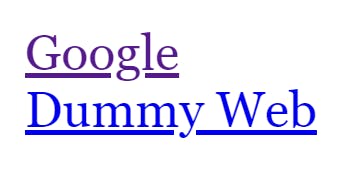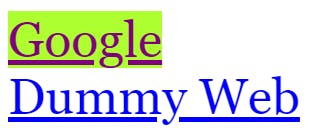[CSS] Pseudo-Classes - Explained with Examples
hover, link, focus, visited. CSS selectors.
Introduction
A pseudo-class is used to define a special state of an element. It is used to give a style to the element when a certain event happens. For example, you might have seen that a non-visited link is a blue color, but a visited link is a purple color
Example:

This can be done by using pseudo-classes which we will be introduced in this article.
Pseudo-classes that will be covered:
hover - when a user puts a mouse cursor on the selected area.
link - when there is an unvisited link.
visited - when there is a visited link.
*These three(3) pseudo-classes except focus are mostly used with the <a> tag.
focus - when there is a focus by the user.
active - when an element is activated by the user.
*focus is often used with an input box.
*active is often used with a button.
nth-child(2n+1) & nth-child(2n) - gives a style to either odd or even child.
first-child - gives a style only to the first child.
last-child - gives a style only to the last child.
*These three(3) pseudo-classes are often used with tables and lists (where there is a parent and child relationship)
Anchor Pseudo-classes
HTML code:
<a href="https://google.com">Google</a>
<br />
<a href="https://exampleweb.com">Dummy Web</a>
CSS code:
a:hover {
background-color: greenyellow;
}
a:link {
color: blue;
}
a:visited {
color: purple;
}

hover effect:

:focus
focus effect occurs when a user gives a focus on a certain element.
HTML code:
<input type="text" name="" id="" />
CSS code:
input:focus {
border: 2px solid black;
}
When there is a focus:

Without a focus effect:

Do you notice that the border is thicker when there is a mouse cursor focus?
:active
active effect occurs when the user clicks a button or whenever the user activates the element.
HTML code:
<button>Subscribe Jay's Devlog!</button>
CSS code:
button:active {
border: 2px solid palevioletred;
border-radius: 5px;
}
With active effect:

Without active effect:

Child-related Pseudo-classes
:nth-child can receive four parameters:
2n
2n+1
even
odd
2n is the same as even, and 2n+1 is the same as odd. The result will be the same.
HTML code:
<table>
<thead>
<tr>
<th>Student ID</th>
<th>First Name</th>
<th>Last Name</th>
<th>Degree</th>
</tr>
</thead>
<tbody>
<tr>
<td>1200</td>
<td>John</td>
<td>Doe</td>
<td>Computer Science</td>
</tr>
<tr>
<td>1300</td>
<td>Mary</td>
<td>Doe</td>
<td>Business</td>
</tr>
<tr>
<td>1400</td>
<td>Jane</td>
<td>Lee</td>
<td>Accounting</td>
</tr>
<tr>
<td>1500</td>
<td>Jason</td>
<td>Hamilton</td>
<td>Psychology</td>
</tr>
</tbody>
</table>
CSS code:
table,
th,
td {
border: 1px solid black;
border-collapse: collapse;
}
tbody > tr:nth-child(2n) {
background-color: lightsalmon;
}
Table:

Do you notice that only the even number of the <tr> has a pink background?
*The (>) symbol is called a combinator selector. It basically selects all the <tr> element that has a <tbody> tag as their parents.
There are other types of combinator selectors, such as (~) and (+). If you want to find out more about them, check out this article:
For the other two classes (first-child and last-child), the HTML code will be the same, so I will just share my CSS codes.
CSS code (first-child):
table,
th,
td {
border: 1px solid black;
border-collapse: collapse;
}
tbody > tr:first-child {
background-color: lightsalmon;
}
Table:

CSS code (last-child):
table,
th,
td {
border: 1px solid black;
border-collapse: collapse;
}
tbody > tr:last-child {
background-color: lightsalmon;
}
Table:

Conclusion
This is all I have for you today. The pseudo-classes are quite interesting, especially :hover in my opinion. If you use them when needed, you will be able to write your code more efficiently.